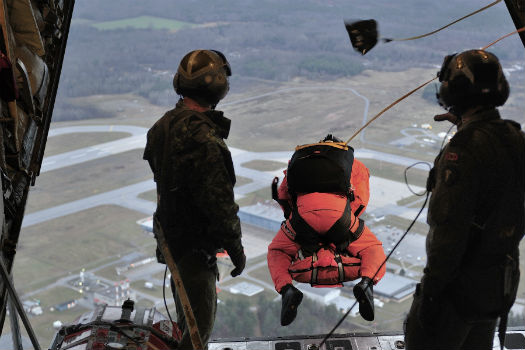by Captain Alexandre Cadieux | December 17, 2014
Estimated reading time 4 minutes, 12 seconds.
CH-149 Cormorant helicopter flight engineers Corporal Tony Brown (left) and Corporal Kent Campbell, from 442 Transport and Rescue Squadron out of 19 Wing Comox, B.C., operate the hoist as they lower personnel to the ground during a search and rescue exercise near Abbotsford, B.C. Bombardier Albert Law Photo
The Canadian Armed Forces, through the national search and rescue (SAR) system, maintains a continuous watch over almost 10 million square kilometres of land and water that include challenging mountainous and Arctic areas. Responding to the many aeronautical and maritime incidents is a task of tremendous proportions.
Understandably, the various Royal Canadian Air Force (RCAF) SAR squadrons positioned across the country, distributed among the three SAR regions, bear the majority of the responsibility for this important mission.
What is less known is the role played by 1 Canadian Air Division (1 CAD) in shaping the successful accomplishment of SAR in Canada. 1 CAD is the coordinator of force generation, which looks at getting our personnel the right gear and training to do the mission.
One of the pivotal sections looking after the RCAF SAR community is managed by the senior staff officer for SAR, Lieutenant-Colonel Bryn Elliott, as part of 1 CAD fleet readiness directorate.
A search and rescue technician from 413 Transport and Rescue Squadron jumps out of a CC-130 Hercules aircraft over 14 Wing Greenwood, N.S., during a jump camp held on Nov. 20. Master Corporal Shane Blandin (left), the loadmaster, and Captain Bryan Aubin, the navigator, ensure safety. Corporal Blandin counts parachutes as they open. Master Corporal Johanie Maheu Photo
“This year brought a few initiatives to fruition that are important to the SAR community”, said Lieutenant-Colonel Elliott. “First, we will resume the training to deliver the capability of confined-area diving for search and rescue technicians.
“For the past two years, it had been suspended due to various reasons but the recent release of the SAR tech task-to-mission analysis confirmed it was required as part of our SAR capability. Support from RCAF leadership to the study’s conclusions initiated the return.
“Also, we have implemented a new rescue harness for the SAR techs as an interim replacement for the aircrew restraint harness,” he added. “Feedback from the operators indicated that the old harness was insufficient to the needs of SAR techs. The interim harness is much lighter and allows easier movement in a rescue scenario. It was designed specifically for rescue operations and has been used extensively by organizations like the United States Coast Guard Rescue Swimmers.
“Lastly,” Lieutenant Colonel Elliott said, “we are now developing the concept to operationalize free-fall as an insertion method for SAR techs. The RCAF commander, through his acceptance of the SAR tech task-to-mission analysis conclusions, directed us to increase our readiness by using free-fall in operations instead of only as a training mechanism. In the future, this could provide the RCAF the flexibility to insert SAR techs from aircraft that do not allow for static-line parachuting.”
Clearly, the work to prepare our personnel to face the challenges that our country presents is never done. However, the work done on these fronts will ensure that the SAR community is better supported and set up for success.



